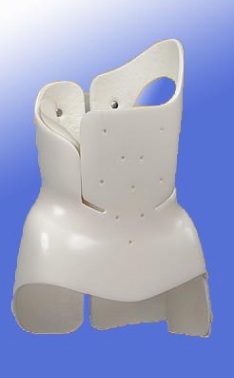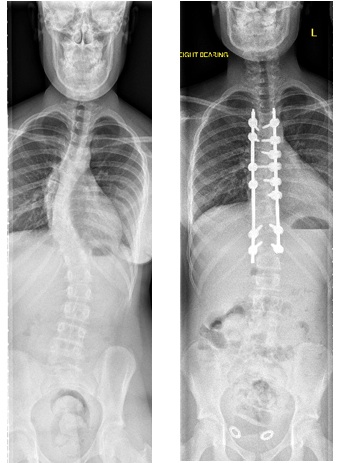- Home
- Patient Area
- Adolescent Idiopathic Scoliosis
What is adolescent idiopathic scoliosis?
This is the name given to a scoliosis which starts after the age of 10 years in an otherwise healthy person and has no obvious cause. It may also be called late onset idiopathic scoliosis.
The cause of idiopathic scoliosis is being investigated world wide. It is probably genetic, but no one knows for sure yet.
Adolescent idiopathic scoliosis may be abbreviated to AIS.
A scoliosis means that the spine is curved abnormally when viewed from the front or the back. It can lead to the trunk and shoulders no longer being symmetrical. Sometimes the shoulders aren’t level anymore. Sometimes the head is not level or the pelvis is not level. The rib cage can also push out on one side so that it becomes prominent - this is known as a rib hump. The severity of the abnormalities can vary between people and can change with time.
How would I know I had scoliosis?
Either you or someone else may notice that you are not standing straight or that you have changes in the shape of your spine.
You may notice:
- Rib cage sticking out on one side especially at the back
- Shoulders not being level
- Your hip or waist sticking out
- Your head tilting over to one side of your trunk
- Clothes not fitting well anymore
- Not being able to stand up straight
- You may have pain as well as the changes above
Why does it matter?
Mostly, your scoliosis just needs to be assessed and then observed. Most people with AIS do not need to have anything more than regular check ups until fully grown.
Sometimes the shape changes can make you feel very awkward and worried about your appearance. Some people do get very embarrassed about their shape, this is not unusual. The shape can change as you grow, particularly at the time of growth spurts.
If scoliosis worsens, it can affect the mechanics of your spine and result in aching or pain.
Occasionally, especially if the scoliosis affects you early in life, it can affect the development and function of your lungs. This does need to be treated or at least monitored. Thankfully, this is not often.
Scoliosis that has started as a child or teenager can go on to have wear and tear changes later in life resulting in pain or nerve pressure.
What should I do if I think I have a scoliosis?
Speak to your GP. Your GP will be able to examine you to see if there is a scoliosis.
If your GP is concerned, they will refer you to a Spine Surgeon, Paediatrician or Orthopaedic Surgeon at a hospital for further tests.
Once a scoliosis is confirmed, you will need to see a Spine Surgeon at a recognised spine centre who will assess you fully and talk about what you may need. The GP, Paediatrician or Orthopaedic Surgeon will refer you on to the Spine Surgeon.
Do not ignore it if you think you have a scoliosis. More often than not, it will be nothing serious and just require monitoring at the hospital. However it is important to be sure, so having someone check you properly is important.
If you have no pain, you can usually carry on with your normal activities, including sports. If you have pain, it might be better to stop sports until you are seen.
How will the doctors check if I have a scoliosis?
The first thing the GP or specialist will do is talk to you about your concerns. They will ask you questions about your health generally, how the problems are affecting you and try to get an idea how much more growth and development you have if you are not fully grown yet.
The doctors will want to examine you. They will need to examine your back, your ams and your legs, so you will need to get undressed for this. Often the hospital will give you a gown, but wearing shorts and a T shirt or sports bra may make you feel more comfortable. The examination will look at your back and see how flexible it is. They will look at your back whilst you are bent forwards as this reveals the scoliosis more (Adam’s position). Your arms and or legs will be examined to make sure the spinal cord is working normally.
The Spine Surgeon will send you for X - rays. These are necessary to see if there is a scoliosis and how bad it is. The Spine Surgeon will measure the angle of the scoliosis on the X - ray (Cobb angle).
After all of this, the doctors may want you to go for further tests such as an MRI scan or surface topography (a way of mapping the contours of your spine).
If the plan is to monitor your scoliosis, you will be asked to return in a few months (often 6-9 months) for another examination and X - ray.
How can you treat adolescent idiopathic scoliosis?
Observation
The commonest treatment plan is just to be monitored. This will be by 6-9 monthly appointments at the hospital by the Spine Surgeon. The appointment will usually involve you being examined again and having an X - ray. This is to see if your scoliosis is worsening. If it remains roughly the same each time you are seen then they will continue to monitor you until you are fully grown (between the age of 16 to 18 years old).
Exercise
There is no need to avoid sport or exercise when you have AIS. It is actually better for you to remain active and to have good core muscles. Unfortunately there is no strong evidence that exercise alone stops a scoliosis progressing or improves it. There are many ongoing studies that may help prove the role of exercise one way or another.
Bracing
Sometimes a brace is suggested. Braces are usually used for milder to moderate curves (20 to 40 degree Cobb angle on the X - rays). The braces are usually rigid and need to be worn 23 hours a day. They can be worn under your clothes. It has been found that braces only work if they are used more or less constantly. You can take the brace off to wash, dress and when you are doing sporting activities. Braces were not used all the time in the UK as we did not feel that most patients would wear a brace for the amount of time necessary. A recent study has made bracing more popular again. The study confirmed that the time in the brace made the difference to the scoliosis.

A Boston scoliosis brace
Surgery
The commonest UK operation for AIS is a posterior instrumented correction and fusion. This means an operation through a long scar on the back of you, to put rods and screws into the bones of your spine and straighten your spine. This operation also involves using some form of bone graft to fuse the spine to stop your curve deteriorating or coming back.
The aim of the operation is to stop things worsening and to hopefully improve your appearance. Your Spine Surgeon will talk to you about the risks and benefits of this type of an operation to you. Thankfully, the risk of serious complications is low.

Example of Surgery
.png)